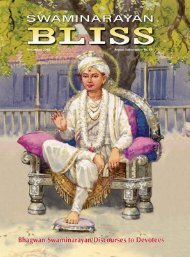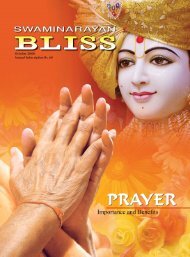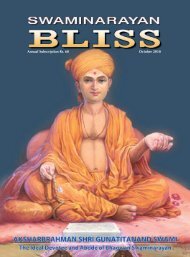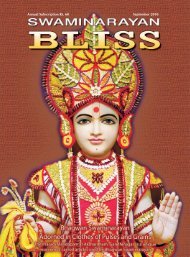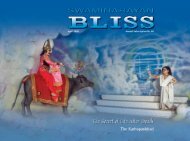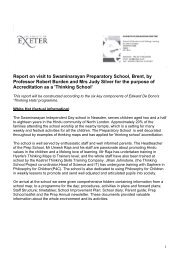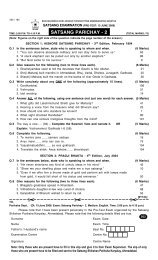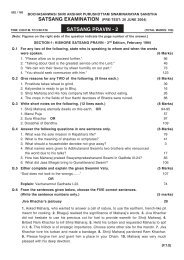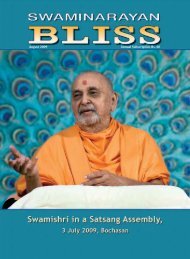February 2009 Annual Subscription Rs. 60
February 2009 Annual Subscription Rs. 60
February 2009 Annual Subscription Rs. 60
Create successful ePaper yourself
Turn your PDF publications into a flip-book with our unique Google optimized e-Paper software.
(Ishãvãsya Upanishad: 2). This means he is not<br />
bound by any karma, i.e. he attains liberation.<br />
One only has to take another birth if one is<br />
bound by karma. This no longer remains for a<br />
karmayogi.<br />
But for the person who does not imbibe this<br />
wisdom-filled karma-yoga in his life, the Upanishad<br />
says, ‘•Êà◊„UŸÙ ¡ŸÊ—’ – ‘Ãtmahano janãhã’ –<br />
‘He is his own destroyer’ (Ishãvãsya Upanishad:<br />
3). Not only that, “Ãapple ¬˝appleàÿÊÁ÷ªë¿UÁãÔ – ‘Te pretyãbhigacchanti’<br />
– ‘They go to joyless, extremely<br />
miserable demonic worlds’ (Ishãvãsya Upanishad:<br />
3).<br />
In this way, these mantras teach us the<br />
lessons of karma-yoga and seva.<br />
Now let us understand another important<br />
principle.<br />
5. THE COEXISTENCE OF KNOWLEDGE<br />
AND KARMA<br />
As we have seen above, words like “߸‡ÊÊ flÊSÿ◊˜<br />
ߌ¢ ‚fl¸◊˜” better our understanding. And words<br />
like “∑ȧfl¸ãŸappleflapple„U ∑§◊ʸÁáÊ” give us the beneficial advice<br />
to perform karmas with this lofty understanding.<br />
Only karmas performed with such an<br />
understanding lead to true success in life. This<br />
is what can be concluded when we combine<br />
both mantras. For this very reason, the next six<br />
mantras emphasize the co-existence of knowledge<br />
(jnãn) and karma. Let us understand them<br />
briefly.<br />
We will be able to understand this more<br />
clearly using ‘Andhapangu Nyãya’ – one man<br />
can see, but is lame; another can walk, but he<br />
is blind. If both get together, they can accomplish<br />
a task. This is called ‘Andhapangu<br />
Nyãya’. The same applies here to knowledge<br />
and karmas. Karmas alone are blind; knowledge<br />
alone is lame. They both need each<br />
other. The bliss of liberation can only be<br />
attained when they are both combined. This is<br />
a matter of eradicating laziness and ignorance.<br />
There are those who remain engulfed<br />
in worldly karmas without incorporating the<br />
knowledge of Brahman and Parabrahman into<br />
their karmas. On the other hand, there are<br />
those who remain engulfed in theoretical discussions<br />
on the shastras and do not perform<br />
any karmas. Both have been harshly criticized<br />
in the Upanishad: ‘•ãœ¢ Ã◊— ¬˝Áfl‡ÊÁãÃ<br />
ÿapple˘ÁfllÊ◊ȬʂÃapple– ÃÃÙ ÷Íÿ ßfl Ãapple Ã◊Ù ÿ ©U ÁfllÊÿÊ¢ ⁄UÃÊ—H’<br />
(Ishãvãsya Upanishad: 9). Here, the word<br />
vidyã has been used for knowledge and avidyã<br />
for that which is different to knowledge, i.e.<br />
karmas. So, “Those who act without attaining<br />
the previously described knowledge become<br />
entangled in the intense darkness of mãyã.<br />
While those who just talk about that knowledge<br />
and perform no karmas are pushed into<br />
an even greater darkness.”<br />
However, for those who have achieved a balanced<br />
synthesis of knowledge and karmas; and<br />
have affirmed the importance of both, the<br />
Upanishad says, ‘ÁfllÊ¢ øÊ˘ÁfllÊ¢ ø ÿSÃŒ˜ flappleŒÊ÷ÿ¢ ‚„U–<br />
•ÁfllÿÊ ◊ÎàÿÈ¢ ÃËàflʸ ÁfllÿÊ˘◊ÎÃ◊‡ŸÈÃappleH’ – ‘One in<br />
whose life knowledge and karma co-exist, such<br />
a person overcomes death, i.e. attains immortality<br />
and liberation’ (Ishãvãsya Upanishad: 11).<br />
Here, one learns that knowledge and karma are<br />
not antithetical or opposed to each other, but<br />
supplementary. Now let us acquaint ourselves<br />
with a few of the divine prayers that this Upanishad<br />
includes.<br />
6. DIVINE AND HUMBLE PRAYERS<br />
Hearing the eternal principles of “߸‡ÊÊ flÊSÿ◊˜<br />
ߌ¢ ‚fl¸◊˜” and “∑ȧfl¸ãŸappleflapple„U ∑§◊ʸÁáÊ”, the spiritual aspirant<br />
becomes eager to realize them. He realizes<br />
that the true and best way of attaining these<br />
goals easily is through prayer. Prayer is the<br />
humble voice of surrender. Here are those<br />
words.<br />
■ ÃØ àfl¢ ¬Í·ãŸ¬ÊflÎáÊÈ – ‘Unveil the face of truth’<br />
“Á„U⁄Uá◊ÿappleŸ ¬ÊòÊappleáÊ ‚àÿSÿÊÁ¬Á„Uâ ◊Èπ◊˜– ÃØ àfl¢<br />
¬Í·ãŸ¬ÊflÎáÊÈ ‚àÿœ◊ʸÿ ŒÎc≈UÿappleH” – ‘O Paramãtmã, the<br />
nourisher of all! The face of truth has been covered<br />
by a golden vessel. Unveil it so that I may<br />
12 Swaminarayan Bliss ◆ <strong>February</strong> <strong>2009</strong>



